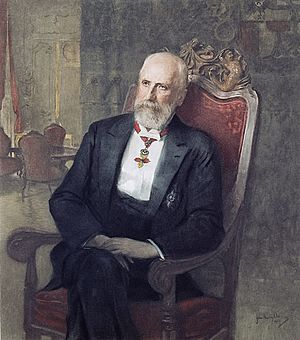Johann II, Prince of Liechtenstein facts for kids
Quick facts for kids Johann II |
|||||
|---|---|---|---|---|---|

1908 painting of Johann II of Liechtenstein
|
|||||
| Prince of Liechtenstein | |||||
| Reign | 12 November 1858 – 11 February 1929 | ||||
| Predecessor | Aloys II | ||||
| Successor | Franz I | ||||
| Born | 5 October 1840 Eisgrub, Margraviate of Moravia, Austrian Empire |
||||
| Died | 11 February 1929 (aged 88) Valtice, First Czechoslovak Republic |
||||
| Burial | Church of the Nativity of the Virgin Mary, Vranov | ||||
|
|||||
| House | Liechtenstein | ||||
| Father | Aloys II, Prince of Liechtenstein | ||||
| Mother | Countess Franziska Kinsky of Wchinitz and Tettau | ||||
Johann II (born October 5, 1840 – died February 11, 1929) was a very important ruler of Liechtenstein. He was also known as Johann II the Good. He was the Prince of Liechtenstein for a very long time, from 1858 to 1929. His reign lasted for 70 years and 91 days. This makes it one of the longest reigns in European history. Only Louis XIV of France ruled longer in Europe.
Contents
Becoming Prince
Johann II was the older son of Aloys II, Prince of Liechtenstein. His mother was Countess Franziska Kinsky of Wchinitz and Tettau. He became Prince shortly after his 18th birthday. His mother helped him with his duties for a short time. This was so he could finish his education before fully taking over.
New Laws and Changes
In 1862, Prince Johann II created Liechtenstein's first constitution. A constitution is a set of rules for how a country is governed. Later, after World War I, he gave Liechtenstein a new constitution in 1921.
This new constitution gave many political rights to the people of Liechtenstein. It made the country a constitutional monarchy. This means the Prince shares power with elected representatives. This constitution is still used today, with some updates.
Liechtenstein also left the German Confederation in 1866. Soon after, the country's army was ended. It was seen as too expensive and not needed.
Liechtenstein's Friends Around the World
Prince Johann II changed Liechtenstein's relationships with other countries. He made the country less close with Austria-Hungary. Instead, he built stronger ties with Switzerland, especially after World War I.
Liechtenstein stayed neutral during World War I. This means they did not pick a side in the war. After the war, Liechtenstein formed a special agreement with Switzerland. This was a customs union, which made trade easier between them. In 1924, the Swiss franc became Liechtenstein's official money.
A Prince Who Loved Art
Johann II was known for supporting arts and sciences. He added many valuable pieces to the Liechtenstein Princely Collections. These are special collections of art owned by the royal family.
Even though he supported art, Johann II was a private person. He did not often go to social events. He never got married or had children.
Between 1905 and 1920, Schloss Vaduz was fixed up and made bigger. This is a famous castle in Liechtenstein. Prince Johann II did not live in the castle himself. But his family members who became Prince after him made it their home in 1938.
When Johann II passed away in 1929, his brother Franz I became the new Prince.
See also
 In Spanish: Juan II de Liechtenstein para niños
In Spanish: Juan II de Liechtenstein para niños
Images for kids

